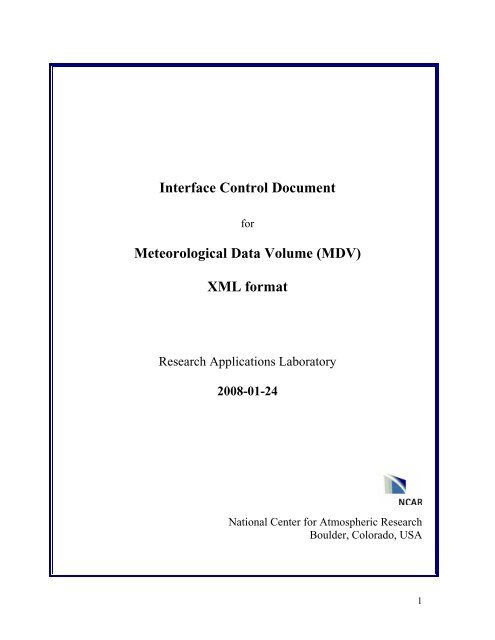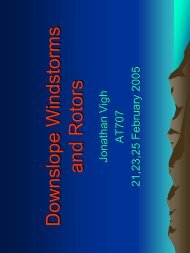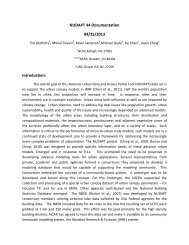(MDV) XML format
(MDV) XML format
(MDV) XML format
Create successful ePaper yourself
Turn your PDF publications into a flip-book with our unique Google optimized e-Paper software.
Interface Control Document<br />
for<br />
Meteorological Data Volume (<strong>MDV</strong>)<br />
<strong>XML</strong> <strong>format</strong><br />
Research Applications Laboratory<br />
2008-01-24<br />
National Center for Atmospheric Research<br />
Boulder, Colorado, USA<br />
1
1 INTRODUCTION 3<br />
2 <strong>MDV</strong> CONCEPTS 3<br />
3 FILE FORMAT OVERVIEW 4<br />
3.1 File structure 4<br />
3.2 Binary data types 4<br />
3.3 Byte ordering 5<br />
3.4 File naming conventions 5<br />
3.5 The X-Y grid 6<br />
3.6 Data storage order 7<br />
4 META-DATA DETAILS 7<br />
4.1 <strong>XML</strong> schema 7<br />
4.2 Buffer file name 7<br />
4.3 Master header meta-data 8<br />
4.4 Field meta-data 11<br />
4.5 Projection meta-data 16<br />
4.6 XY grid meta-data 16<br />
4.7 Vertical levels grid meta-data 17<br />
4.8 Chunk meta-data 18<br />
5 APPENDIX 19<br />
5.1 <strong>MDV</strong> <strong>XML</strong> schema 19<br />
5.2 Example of a simple <strong>XML</strong> meta-data file 26
<strong>MDV</strong> <strong>XML</strong> ICD Version 1.0 2008-01-24<br />
1 Introduction<br />
<strong>MDV</strong> <strong>XML</strong> Interface Control Document<br />
The Meteorological Data Volume (<strong>MDV</strong>) <strong>format</strong> for gridded data was developed by the Research<br />
Applications Laboratory at NCAR in the early 1990s. At the time a number of gridded data <strong>format</strong>s were<br />
in use at RAL. To simplify the data systems, it was decided to standardize on a single gridded data <strong>format</strong><br />
for RAL use.<br />
No public data standard available at the time was considered suitable in terms of data encapsulation and<br />
internal compression. <strong>MDV</strong> evolved as a data <strong>format</strong> unique to RAL and NCAR. It is an effective <strong>format</strong><br />
for gridded data, with good meta-data support and an efficient internal compression capability which<br />
allows for selected decompression of a single plane from a single data field.<br />
Since the <strong>MDV</strong> <strong>format</strong> was developed primarily for use at NCAR, a more widely-accepted standard is<br />
needed for transferring <strong>MDV</strong> data to other organizations. The <strong>XML</strong>/binary version of <strong>MDV</strong> was<br />
developed for this purpose. It combines the advantages of <strong>XML</strong> with the efficiency of storing large<br />
gridded data field in binary <strong>format</strong>.<br />
This document describes the <strong>MDV</strong> <strong>XML</strong> <strong>format</strong>.<br />
2 <strong>MDV</strong> concepts<br />
<strong>MDV</strong> is a general purpose data file <strong>format</strong> for storing two- and three-dimensional gridded data.<br />
<strong>MDV</strong> files each contain data for a single time. Time searching and retrieval is handled by a time-based<br />
file naming convention. Support is provided for date/time stamping for creation, expiration, and<br />
forecasting times.<br />
<strong>MDV</strong> provides capabilities for managing multiple data fields in a single file. For example, one <strong>MDV</strong> file<br />
might contain radar data with fields of reflectivity and radial velocity, or model data with temperature,<br />
humidity and wind speed as separate fields.<br />
In the (X,Y) dimension, <strong>MDV</strong> supports a number of projection types, including Lambert Conformal<br />
Conic, Polar Stereographic, the simple Latitude-Longitude grid (also known as Simple Cylindrical) and<br />
Cartesian and polar coordinates for radar data.<br />
In the vertical dimension, <strong>MDV</strong> supports a number of vertical coordinate types, including height in km or<br />
ft, pressure levels, flight levels for aviation, sigma levels for numerical models and elevation angles for<br />
radar data.<br />
Data fields may be represented as 4-byte floating point, 2- and 1-byte scaled integers and 4-byte RGBA<br />
image pixels. The data is stored in network-byte-order (big-endian order).<br />
Internal compression is supported, with each field individually compressed using the gzip compression<br />
scheme, for speed of access.<br />
The <strong>MDV</strong> <strong>format</strong> is extensible in that it provides space and access capabilities for optional generic<br />
“chunk” data defined by the <strong>MDV</strong> user. Chunk data allows <strong>MDV</strong> users to attach to the data set additional<br />
in<strong>format</strong>ion that is not suitable for storage in the <strong>MDV</strong> headers or data fields. As examples, the user may<br />
wish to store the elevation angles from which a Cartesian radar grid was derived, or the navigation header<br />
for satellite data.<br />
3
<strong>MDV</strong> <strong>XML</strong> ICD Version 1.0 2008-01-24<br />
3 File <strong>format</strong> overview<br />
3.1 File structure<br />
The data set for each time is split into two files, (a) and <strong>XML</strong> meta-data file and (b) a binary data<br />
buffer file.<br />
Included in the meta-data <strong>XML</strong> are byte offsets and lengths for the field data in the binary buffer<br />
file.<br />
When a data set is read, the <strong>XML</strong> is read first, and the meta-data then identifies the data area in<br />
the buffer file.<br />
3.2 Binary data types<br />
The data fields in <strong>MDV</strong> use the following data types:<br />
• unsigned scaled 1-byte integer<br />
• unsigned scaled 2-byte integers<br />
• unsigned 4-byte integers for representing RGBA image values<br />
4
<strong>MDV</strong> <strong>XML</strong> ICD Version 1.0 2008-01-24<br />
• IEEE 4-byte floating point values<br />
3.3 Byte ordering<br />
For data types with a length of more than 1 byte, the ordering of the data bytes is important in interpreting<br />
the data.<br />
All <strong>MDV</strong> binary data is stored in so-called big-endian or network-byte-order. This is the native byte<br />
ordering for platforms such as SUN, and the opposite of that used by INTEL and AMD processors<br />
common to LINUX and Windows systems.<br />
When reading <strong>MDV</strong> data on a little-endian platform, the multi-byte values will require byte-swapping.<br />
3.4 File naming conventions<br />
For meteorological data, one of the most important attributes is time. Each <strong>MDV</strong> file contains data for a<br />
single time.<br />
<strong>MDV</strong> files are named according to the time of the data stored in the file. As a general rule, UTC times are<br />
used in all <strong>MDV</strong> data.<br />
A number of times may be applicable:<br />
• valid time - the time at which an observation was made. This is also referred to as<br />
‘observation time’.<br />
• generate time - the time at which a model was run or a forecast was generated.<br />
• forecast time - the time at which a forecast is valid.<br />
• lead time - the time difference between the forecast time and generate time for a<br />
forecast.<br />
<strong>MDV</strong> <strong>XML</strong> files are named in two ways, as follows.<br />
By valid time:<br />
data_dir/yyyymmdd/hhmmss.mdv.xml<br />
data_dir/yyyymmdd/hhmmss.mdv.buf<br />
By generate time and lead time:<br />
data_dir/yyyymmdd/g_hhmmss/f_llllllll.mdv.xml<br />
data_dir/yyyymmdd/g_hhmmss/f_llllllll.mdv.buf<br />
Most data sets are stored using valid time. The files for a single day are stored in a subdirectory<br />
(yyyymmdd), named after the year, month and day. The files within the directory are named according<br />
to the hour, minute and second (hhmmss).<br />
For forecast-style data, you can choose whether to use the valid-time naming convention above, or<br />
whether to use the more complicated generate-time and lead-time convention. The former is simpler, but<br />
can lead to over-writing of data sets if forecast results from different generate times have the same valid<br />
time. For example, for a model run at 0 UTC and 6 UTC, the 9-hour forecast from the 0 UTC run will be<br />
over-written by the 3-hour forecast from the 6 UTC run because they will both be valid at 09 UTC.<br />
5
<strong>MDV</strong> <strong>XML</strong> ICD Version 1.0 2008-01-24<br />
To avoid over-writing, use the second naming convention. There are 2 levels of sub-directory. The name<br />
of the upper one is based on the year, month and day of the generate time (yyyymmdd). The lower one<br />
is named g_hhmmss, based on the hour, minute and second of the generate time.The files themselves<br />
are named using an 8-digit lead time in seconds (f_llllllll). For example, the 6-hour (21600<br />
second) forecast for the 9 UTC model run on 1 July 2005 will be named:<br />
20050701/g_090000/f_00021600.mdv.xml<br />
20050701/g_090000/f_00021600.mdv.buf<br />
3.5 The X-Y grid<br />
<strong>MDV</strong> data sets are 2-D or 3-D grids. The grid spacing is regular in X and Y, while in the vertical<br />
the spacing may be irregular.<br />
Most data grids conform to a standard projection, such as a regular latitude-longitude grid<br />
(Simple Cylindrical) or Lambert Conformal.<br />
The following figure shows how the grid geometry works.<br />
For each grid cell, the location of the data is referenced to the center of the grid cell.<br />
The (X,Y) location of a grid cell may be found as follows:<br />
x = minx + ix * dx<br />
y = miny + iy * dy<br />
6
<strong>MDV</strong> <strong>XML</strong> ICD Version 1.0 2008-01-24<br />
For most projections, the grid units are in km. For the latlon grid projection (see below), the<br />
units are in degrees. For radar projections, the units may also be in degrees.<br />
3.6 Data storage order<br />
The field data is stored in an array, packed in X-Y-Z ordering, meaning that X varies the fastest, Y next<br />
and Z slowest.<br />
The first byte in the array is at the SW corner of the grid and at the lowest vertical level.<br />
To start unpacking the data, begin at the SW corner of the grid and at the lowest vertical level.<br />
Move first in the X dimension from West to East in the first row along the South edge of the grid, for the<br />
lowest vertical level, incrementing X as you go.<br />
Once one row in X is completed, increment Y and go back to the West edge.<br />
Then, repeat the process from West to East, this time in the second row.<br />
Continue until the first vertical level is unpacked.<br />
Then, the process repeats for each vlevel in turn, from the bottom to the top.<br />
4 Meta-data details<br />
4.1 <strong>XML</strong> schema<br />
The <strong>MDV</strong> <strong>XML</strong> meta-data conforms to an <strong>XML</strong> schema which is published on the web at:<br />
http://www.ral.ucar.edu/xml/schemas/mdv.1.0.xsd<br />
The current version of the schema is included in the appendix. An simple example of an <strong>MDV</strong><br />
<strong>XML</strong> file is also included in the appendix..<br />
4.2 Buffer file name<br />
The name of the buffer file is stored with the <strong>XML</strong> tag buf-file-name.<br />
7
<strong>MDV</strong> <strong>XML</strong> ICD Version 1.0 2008-01-24<br />
4.3 Master header meta-data<br />
The master header element occurs only once. The following tags may be found in the master<br />
header. Refer to the schema for further details.<br />
Note: all times are in UTC.<br />
<strong>XML</strong> tag<br />
time-valid<br />
time-gen<br />
forecast-lead-secs<br />
time-written<br />
time-user<br />
time-begin<br />
time-end<br />
time-expire<br />
data-set-name<br />
data-set-info<br />
data-set-source<br />
sensor-lon<br />
sensor-lat<br />
sensor-alt<br />
data-dimension<br />
Description<br />
Valid time of the data set. This is the principal time used for the data<br />
set, to name the files, retrieve data, etc. For observation data, this is<br />
normally set to the observation time. For model data, this is set to<br />
time-gen + forecast-lead-secs .<br />
Generate time for forecast data sets. Not used for non-forecast data, in<br />
which case value = 0.<br />
Lead time of the forecast, relative to gen-time. Only applies to forecast<br />
data. Should be equal to time-valid minus time-gen.<br />
Not used for non-forecast data, in which case value = 0.<br />
Time at which the file was written.<br />
User-specific data. Not used internally by <strong>MDV</strong>. Normally 0.<br />
Start time of data set, if applicable. Often set equal to time-valid.<br />
End time of data set, if applicable. Often set equal to time-valid.<br />
Not used. Included for backwards compatibility.<br />
Data set name, in ASCII. For in<strong>format</strong>ion only. 127 characters or less.<br />
Data set in<strong>format</strong>ion in ASCII. For in<strong>format</strong>ion only. 511 characters or<br />
less.<br />
Data set source, in ASCII. for in<strong>format</strong>ion only. 127 characters or less.<br />
Longitude of the sensor, in degrees, if applicable. Otherwise 0.<br />
E longitudes are positive.<br />
An example would be the location of a radar.<br />
Latitude of the sensor, in degrees, if applicable. Otherwise 0.<br />
N latitude are positive.<br />
Altitude of the sensor, in km MSL, if applicable. Otherwise 0.<br />
2 if all fields contain 2D data, 3 if any fields contain 3D data.<br />
8
<strong>MDV</strong> <strong>XML</strong> ICD Version 1.0 2008-01-24<br />
<strong>XML</strong> tag<br />
data-collection-type<br />
Description<br />
Text string used as in<strong>format</strong>ion on how the data was obtained or<br />
generated. This is for in<strong>format</strong>ion purposes only. It is not used internally<br />
by <strong>MDV</strong>.<br />
Currently understood values are:<br />
• measured: data was measured by an instrument<br />
• extrapolated: data was created by a forecasting algorithm<br />
which uses extrapolation (nowcasting)<br />
• forecast: data was forecast by a model or algorithm<br />
• synthesis: data was synthesized<br />
• mixed: mixture of types<br />
• rgba-image: derived from an RGBA image<br />
• rgba-graphic: created as an RBGA graphic<br />
• climo-analysis: climatology of modeled data<br />
• climo-observed: climatology of observed data<br />
vlevel-type<br />
This is the vertical level type of the data in the fields. If the vlevel-type<br />
varies from field to field it should be set to variable.<br />
See vlevel-type in the field section for details.<br />
native-vlevel-type<br />
user-data<br />
user-int-0<br />
user-int-1<br />
user-int-2<br />
user-int-3<br />
user-int-4<br />
user-int-5<br />
user-int-6<br />
user-int-7<br />
user-float-0<br />
The native vertical data type of the data, before translation into <strong>MDV</strong>.<br />
See vlevel-type in the field section for details.<br />
User-specific integer data. Not used internally by <strong>MDV</strong>. Normally 0.<br />
User-specific integer data. Not used internally by <strong>MDV</strong>. Normally 0.<br />
User-specific integer data. Not used internally by <strong>MDV</strong>. Normally 0.<br />
User-specific integer data. Not used internally by <strong>MDV</strong>. Normally 0.<br />
User-specific integer data. Not used internally by <strong>MDV</strong>. Normally 0.<br />
User-specific integer data. Not used internally by <strong>MDV</strong>. Normally 0.<br />
User-specific integer data. Not used internally by <strong>MDV</strong>. Normally 0.<br />
User-specific integer data. Not used internally by <strong>MDV</strong>. Normally 0.<br />
User-specific integer data. Not used internally by <strong>MDV</strong>. Normally 0.<br />
User-specific floating pt data. Not used internally by <strong>MDV</strong>. Normally 0.<br />
9
<strong>MDV</strong> <strong>XML</strong> ICD Version 1.0 2008-01-24<br />
<strong>XML</strong> tag<br />
user-float-1<br />
user-float-2<br />
user-float-3<br />
user-float-4<br />
user-float-5<br />
field-grids-differ<br />
n-fields<br />
n-chunks<br />
Description<br />
User-specific floating pt data. Not used internally by <strong>MDV</strong>. Normally 0.<br />
User-specific floating pt data. Not used internally by <strong>MDV</strong>. Normally 0.<br />
User-specific floating pt data. Not used internally by <strong>MDV</strong>. Normally 0.<br />
User-specific floating pt data. Not used internally by <strong>MDV</strong>. Normally 0.<br />
User-specific floating pt data. Not used internally by <strong>MDV</strong>. Normally 0.<br />
false if all fields in the file have the same geometry, true if not.<br />
number of fields in the data set<br />
number of chunks in the data set<br />
10
<strong>MDV</strong> <strong>XML</strong> ICD Version 1.0 2008-01-24<br />
4.4 Field meta-data<br />
There is one field <strong>XML</strong> element for each data field in the file.<br />
The following tags may be found in the field section. Refer to the schema for further details.<br />
<strong>XML</strong> tag<br />
field-name<br />
field-name-long<br />
field-units<br />
field-transform<br />
encoding-type<br />
Description<br />
Field name in ASCII. 15 characters or less<br />
Long field name in ASCII. 63 characters or less<br />
Units for the field data. 15 characters or less.<br />
Transform for the field data. 15 characters or less. For in<strong>format</strong>ional<br />
purposes only. Example is ‘dB’ for power values in dBm.<br />
Encoding type for the data in the field.<br />
<strong>MDV</strong> supports scaled 1-byte and 2-byte integers, 4-byte floating point<br />
and 4-byte RGBA image data.<br />
• int8: unsigned 8 bit scaled integer<br />
• int16: unsigned 16 bit scaled integer<br />
• float32: 32 bit IEEE floating point<br />
• rgba32: RGBA image (4 x 8 bits) - same as TIFF RGBA<br />
See scale and bias below for how to convert scaled integers into floats.<br />
byte-width<br />
Number of bytes per data point. 1 for int8, 2 for int16, 4 for float32<br />
and rgba32.<br />
11
<strong>MDV</strong> <strong>XML</strong> ICD Version 1.0 2008-01-24<br />
<strong>XML</strong> tag<br />
field-name<br />
field-name-long<br />
field-units<br />
field-transform<br />
encoding-type<br />
Description<br />
Field name in ASCII. 15 characters or less<br />
Long field name in ASCII. 63 characters or less<br />
Units for the field data. 15 characters or less.<br />
Transform for the field data. 15 characters or less. For in<strong>format</strong>ional<br />
purposes only. Example is ‘dB’ for power values in dBm.<br />
Encoding type for the data in the field.<br />
<strong>MDV</strong> supports scaled 1-byte and 2-byte integers, 4-byte floating point<br />
and 4-byte RGBA image data.<br />
• int8: unsigned 8 bit scaled integer<br />
• int16: unsigned 16 bit scaled integer<br />
• float32: 32 bit IEEE floating point<br />
• rgba32: RGBA image (4 x 8 bits) - same as TIFF RGBA<br />
See scale and bias below for how to convert scaled integers into floats.<br />
byte-width<br />
field-data-scale<br />
Number of bytes per data point. 1 for int8, 2 for int16, 4 for float32 and<br />
rgba32.<br />
scaling factor for converting between scaled integers and floating point<br />
numbers.<br />
float-val = int-val * scale + bias<br />
int-val = floor((float-val – bias) / scale + 0.5)<br />
field-data-bias<br />
compression-type<br />
bias for converting between scaled integers and floating point numbers.<br />
See field-data-scale.<br />
Internal compression type for the data in the fields.<br />
Currently supported types:<br />
• none: no compression<br />
• gzip: each field is individually compressed with gzip<br />
12
<strong>MDV</strong> <strong>XML</strong> ICD Version 1.0 2008-01-24<br />
<strong>XML</strong> tag<br />
transform-type<br />
Description<br />
Internal compression type for the data in the fields.<br />
Currently supported types:<br />
• none: no compression<br />
• log: natural log transform. Useful for data with a large<br />
dynamic range, such as precipitation amount.<br />
scaling-type<br />
Internal scaling type for the data in the fields. This applies to scaled<br />
integers only. This field is for in<strong>format</strong>ion only. It is not required by<br />
<strong>MDV</strong>.<br />
Currently supported types:<br />
• none: no scaling<br />
• dynamic: scale and bias computed automatically from the<br />
range of the data.<br />
• integer: scale and bias computed automatically from the<br />
range of the data, and then rounded so that values are integral.<br />
• rounded: scale and bias is computed automatically from the<br />
range of the data and then rounded to reasonable values<br />
• specified: scale and bias are set by the user..<br />
missing-data-value<br />
Value set in the field to indicate missing data.<br />
For scaled integer fields, it is important to note that the missing-datavalue<br />
applies to the scaled integer value, not to the floating point<br />
number which it represents. So when testing for missing data in a scaled<br />
integer field, test the field value as it is stored.<br />
bad-data-value<br />
min-value<br />
max-value<br />
data-dimension<br />
dz-constant<br />
Same as missing-data-value. Maintained for backward compatibility.<br />
Minimum floating-point value of the data in the field.<br />
Maximum floating point value of the data in the field.<br />
2 for 2D field., 3 for 3D field.<br />
true if the spacing between the vertical levels is constant, false<br />
otherwise.<br />
13
<strong>MDV</strong> <strong>XML</strong> ICD Version 1.0 2008-01-24<br />
<strong>XML</strong> tag<br />
projection<br />
xy-grid<br />
n-vlevels<br />
vlevel-type<br />
Description<br />
Projection details – see separate table below.<br />
X-Y grid details – see separate table below.<br />
Number of vertical levels in the field<br />
The vertical level type. This describes the vertical coordinate type for<br />
the field data. It is possible that the vlevel type will actually vary from<br />
one level to another, as in the case of a hybrid model. In that case<br />
variable is used here, and the vlevel type is added as an attribute to<br />
the level object.<br />
surface: earth surface field: 2D<br />
sigma-p: sigma pressure levels<br />
pressure: pressure levels, units = mb<br />
height-msl-km: constant altitude, units = km MSL<br />
sigma-z: model sigma Z levels<br />
eta: ETA model levels<br />
theta :isentropic surface, units = Kelvin<br />
mixed: any hybrid vertical grid, seldom used<br />
elevation-angles: radar elevation angles<br />
composite: i.e., max value at any height<br />
cross-section: cross sectional view of a set of planes<br />
satellite: satellite data<br />
flight-level: ICAO flight level (100’s of ft)<br />
earth-conformal: conformal to the surface of the earth. For<br />
example, an image of the earth’s surface.<br />
azimuth-angles: angles in a radar RHI – polar vertical section.<br />
tops-msl-km: radar echo top or cloud tops, in km MSL<br />
height-agl-ft: constant altitude above ground, units = ft<br />
variable: if variable types in fields<br />
native-vlevel-type<br />
vlevels<br />
vert-reference<br />
data-offset-bytes<br />
The vertical level type of the native data from which this field was<br />
derived. See above.<br />
The vertical levels section. See separate table below.<br />
Not used – backward compatibility.<br />
Offset, in bytes, of the start of the field data from the start of the binary<br />
buffer file.<br />
14
<strong>MDV</strong> <strong>XML</strong> ICD Version 1.0 2008-01-24<br />
<strong>XML</strong> tag<br />
data-length-bytes<br />
Description<br />
Length, in bytes, of the field data in the binary buffer. If the field is<br />
compressed, this will be the length of the compressed buffer. If not<br />
compressed, this should be:<br />
grid-nx * grid-ny * n-vlevels * byte-width.<br />
user-int-0 User-specific integer data. Not used internally by <strong>MDV</strong>. Normally 0.<br />
user-int-1 User-specific integer data. Not used internally by <strong>MDV</strong>. Normally 0.<br />
user-int-2 User-specific integer data. Not used internally by <strong>MDV</strong>. Normally 0.<br />
user-int-3 User-specific integer data. Not used internally by <strong>MDV</strong>. Normally 0.<br />
user-int-4 User-specific integer data. Not used internally by <strong>MDV</strong>. Normally 0.<br />
user-int-5 User-specific integer data. Not used internally by <strong>MDV</strong>. Normally 0.<br />
user-int-6 User-specific integer data. Not used internally by <strong>MDV</strong>. Normally 0.<br />
user-int-7 User-specific integer data. Not used internally by <strong>MDV</strong>. Normally 0.<br />
user-int-8 User-specific integer data. Not used internally by <strong>MDV</strong>. Normally 0.<br />
user-int-9 User-specific integer data. Not used internally by <strong>MDV</strong>. Normally 0.<br />
user-float-0 User-specific floating pt data. Not used internally by <strong>MDV</strong>. Normally 0.<br />
user-float-1 User-specific floating pt data. Not used internally by <strong>MDV</strong>. Normally 0.<br />
user-float-2 User-specific floating pt data. Not used internally by <strong>MDV</strong>. Normally 0.<br />
user-float-3 User-specific floating pt data. Not used internally by <strong>MDV</strong>. Normally 0.<br />
user-time-1 User-specific time data. Not used internally by <strong>MDV</strong>. Normally 0.<br />
user-time-2 User-specific time data. Not used internally by <strong>MDV</strong>. Normally 0.<br />
user-time-3 User-specific time data. Not used internally by <strong>MDV</strong>. Normally 0.<br />
user-time-4 User-specific time data. Not used internally by <strong>MDV</strong>. Normally 0.<br />
grib-code<br />
If available, this is the GRIB code for this field.<br />
15
<strong>MDV</strong> <strong>XML</strong> ICD Version 1.0 2008-01-24<br />
4.5 Projection meta-data<br />
The projection in<strong>format</strong>ion occurs inside the field meta-data.<br />
<strong>XML</strong> tag<br />
proj-type<br />
origin-lat<br />
origin-lon<br />
lat1<br />
lat2<br />
tangent-lon<br />
tangent-lat<br />
pole<br />
Description<br />
Type of projection for this field. The projection types which are<br />
important for file-based grids are:<br />
• latlon: simple latitude-longitude grid<br />
• lambert-conformal (conic)<br />
• mercator<br />
• polar-stereograophic<br />
• oblique-stereographic<br />
• flat (radar Cartesian coordinates)<br />
• polar-radar (radar polar coordinates)<br />
Origin of the projection. Applies to all projections except latlon and<br />
lambert-conformal.<br />
Origin of the projection. Applies to all projections. For the latlon<br />
projection, this is the mean longitude of the grid..<br />
Standard parallel 1, lambert-conformal<br />
Standard parallel 2, lambert-conformal<br />
lambert-conformal, oblique-stereographic<br />
oblique-stereographic<br />
polar-stereographic<br />
Values are “N” or “S”<br />
central-scale<br />
rotation<br />
polar-stereographic<br />
Rotation of the grid relative to true N. flat projection only. Used to<br />
align a radar grid with magnetic N.<br />
4.6 XY grid meta-data<br />
The XY grid in<strong>format</strong>ion occurs inside the field meta-data.<br />
16
<strong>MDV</strong> <strong>XML</strong> ICD Version 1.0 2008-01-24<br />
<strong>XML</strong> tag<br />
nx<br />
ny<br />
minx<br />
miny<br />
dx<br />
dy<br />
Description<br />
Number of grid cells in the X dimension<br />
Number of grid cells in the Y dimension<br />
x-coordinate of the center of the SW (lower left) grid cell (km, or deg<br />
for latlon projection)<br />
y-coordinate of the center of the SW (lower left) grid cell(km, or deg for<br />
latlon projection)<br />
grid resolution in the x dimension (km, or deg for latlon projection)<br />
grid resolution in the y dimention (km, or deg for latlon projection)<br />
4.7 Vertical levels meta-data<br />
The vertical level in<strong>format</strong>ion occurs inside the field meta-data. There is a tag,<br />
within which exists an array of tags, one for each vertical level in the grid.<br />
The element specifies the value of the vertical level. The units are dependent upon the<br />
vertical level type.<br />
If the vertical levels all have the same type, the type is specified by the vlevel-type element<br />
which is part of the field element.<br />
If the vertical level types differ for different levels, the vlevel-type element should be set to<br />
variable, and the type for each level is specified with the vtype attribute, which may be<br />
optionally included with each element.<br />
The following units are appropriate for each vlevel type:<br />
Vertical level type<br />
surface<br />
sigma-p<br />
pressure<br />
height-msl-km<br />
sigma-z<br />
Units<br />
none<br />
sigma-p (model)<br />
mb<br />
km MSL<br />
sigma-z (model)<br />
17
<strong>MDV</strong> <strong>XML</strong> ICD Version 1.0 2008-01-24<br />
Vertical level type<br />
eta:<br />
theta<br />
elevation-angles:<br />
composite<br />
satellite<br />
flight-level<br />
earth-conformal<br />
azimuth-angles<br />
tops-msl-km<br />
height-agl-ft<br />
Units<br />
eta (model)<br />
theta<br />
deg<br />
none<br />
none<br />
FL (100’s of feet)<br />
none<br />
deg<br />
km<br />
ft<br />
4.8 Chunk meta-data<br />
Chunks are data buffers the details of which are not necessarily understood by the <strong>MDV</strong><br />
infrastructure. They are essentially ‘user defined’, and they can be used to store any type of data.<br />
There is one chunk <strong>XML</strong> element for each chunk in the file.<br />
Refer to the schema for further details.<br />
<strong>XML</strong> tag<br />
chunk-id<br />
chunk-info<br />
data-offset-bytes<br />
data-length-bytes<br />
Description<br />
Integer ID used for identifying the chunk type. Not understood by <strong>MDV</strong><br />
ASCII text which describes the chunk. 479 characters or less.<br />
Offset, in bytes, of the start of the chunk data from the start of the<br />
binary buffer file.<br />
Length, in bytes, of the chunk data in the binary buffer.<br />
18
<strong>MDV</strong> <strong>XML</strong> ICD Version 1.0 2008-01-24<br />
5 Appendix<br />
5.1 <strong>MDV</strong> <strong>XML</strong> schema<br />
The <strong>MDV</strong> <strong>XML</strong> schema is published on the web at:<br />
http://www.ral.ucar.edu/xml/schemas/mdv.1.0.xsd<br />
The current version of the schema is included below:<br />
<br />
<br />
<br />
<br />
<br />
<br />
<br />
<br />
<br />
<br />
<br />
<br />
<br />
<br />
<br />
<br />
<br />
<br />
<br />
<br />
<br />
<br />
<br />
<br />
<br />
<br />
<br />
<br />
<br />
<br />
<br />
<br />
<br />
<br />
<br />
<br />
<br />
<br />
<br />
<br />
<br />
<br />
<br />
<br />
<br />
<br />
<br />
<br />
<br />
<br />
<br />
19
<strong>MDV</strong> <strong>XML</strong> ICD Version 1.0 2008-01-24<br />
<br />
<br />
<br />
<br />
<br />
<br />
<br />
<br />
<br />
<br />
<br />
<br />
<br />
<br />
<br />
<br />
<br />
<br />
<br />
<br />
<br />
<br />
<br />
<br />
<br />
<br />
The data-collection-type documents how the data was collected<br />
in the field.<br />
int8: unsigned 8-bit scaled integers<br />
int16: unsigned 16-bit scaled integers<br />
fl32: 32-bit IEEE floating point<br />
rgba32: RGBA image pixels<br />
<br />
<br />
<br />
<br />
<br />
<br />
<br />
<br />
<br />
<br />
<br />
<br />
<br />
<br />
<br />
<br />
<br />
<br />
<br />
<br />
<br />
<br />
<br />
<br />
<br />
<br />
<br />
<br />
<br />
<br />
<br />
<br />
20
<strong>MDV</strong> <strong>XML</strong> ICD Version 1.0 2008-01-24<br />
<br />
<br />
<br />
<br />
<br />
<br />
<br />
<br />
<br />
<br />
<br />
<br />
<br />
<br />
<br />
<br />
<br />
<br />
<br />
<br />
<br />
<br />
<br />
<br />
<br />
<br />
<br />
<br />
<br />
<br />
<br />
<br />
<br />
<br />
<br />
<br />
<br />
<br />
<br />
<br />
<br />
<br />
<br />
<br />
<br />
The encoding type of the field data<br />
int8: unsigned 8-bit scaled integers<br />
int16: unsigned 16-bit scaled integers<br />
fl32: 32-bit IEEE floating point<br />
rgba32: RGBA image pixels<br />
<br />
<br />
<br />
<br />
<br />
<br />
<br />
<br />
<br />
<br />
<br />
<br />
<br />
<br />
21
<strong>MDV</strong> <strong>XML</strong> ICD Version 1.0 2008-01-24<br />
<br />
<br />
The compression type of the field data<br />
none: no compression<br />
gzip: each field is individually gzipped<br />
<br />
<br />
<br />
<br />
<br />
<br />
<br />
<br />
<br />
<br />
<br />
The transform applied to create the data.<br />
none: no transform<br />
log: natural log of the data<br />
<br />
<br />
<br />
<br />
<br />
<br />
<br />
<br />
<br />
<br />
<br />
<br />
<br />
<br />
<br />
<br />
<br />
<br />
<br />
<br />
<br />
<br />
<br />
<br />
<br />
<br />
The scaling type used to compute scaled integers<br />
none: no scaling - floats<br />
dynamic: scale and bias computed from dynamic range of the data<br />
rounded: version of dynamic, scale and bias computed by rounding<br />
appropriately<br />
integral: version of dynamic, scale and bias are integer values<br />
specified: scale and bias specified by the caller<br />
<br />
<br />
<br />
<br />
<br />
<br />
<br />
<br />
<br />
<br />
<br />
<br />
<br />
22
<strong>MDV</strong> <strong>XML</strong> ICD Version 1.0 2008-01-24<br />
<br />
<br />
<br />
<br />
<br />
origin-lat and origin-lon are required by all projections.<br />
Some parameters are specific to the projection.<br />
lambert: needs lat1 and lat2<br />
polar stereo: needs tangent-lon, pole and central-scale<br />
oblique-stereo: needs tangent-lat and tangent-lon<br />
flat: needs rotation<br />
<br />
<br />
<br />
<br />
<br />
<br />
<br />
<br />
<br />
<br />
<br />
<br />
<br />
<br />
<br />
<br />
<br />
<br />
<br />
<br />
<br />
The projection type for the field<br />
<br />
<br />
<br />
<br />
<br />
<br />
<br />
<br />
<br />
<br />
<br />
<br />
<br />
<br />
<br />
<br />
<br />
<br />
<br />
<br />
<br />
<br />
<br />
<br />
<br />
<br />
N or S pole for polar stereographic<br />
<br />
<br />
<br />
<br />
23
<strong>MDV</strong> <strong>XML</strong> ICD Version 1.0 2008-01-24<br />
<br />
<br />
<br />
<br />
<br />
<br />
<br />
<br />
<br />
<br />
<br />
<br />
<br />
<br />
<br />
<br />
<br />
<br />
<br />
<br />
<br />
<br />
<br />
<br />
<br />
<br />
<br />
<br />
<br />
<br />
<br />
<br />
<br />
<br />
<br />
<br />
<br />
<br />
<br />
<br />
<br />
<br />
<br />
<br />
<br />
<br />
<br />
<br />
<br />
<br />
<br />
<br />
<br />
<br />
<br />
<br />
<br />
<br />
<br />
<br />
<br />
<br />
24
<strong>MDV</strong> <strong>XML</strong> ICD Version 1.0 2008-01-24<br />
<br />
<br />
<br />
<br />
<br />
<br />
The type of vertical level coordinate<br />
<br />
<br />
<br />
<br />
<br />
<br />
<br />
<br />
<br />
<br />
<br />
<br />
<br />
<br />
<br />
<br />
<br />
<br />
<br />
<br />
<br />
<br />
<br />
<br />
<br />
<br />
<br />
<br />
<br />
<br />
<br />
<br />
<br />
<br />
<br />
<br />
<br />
<br />
<br />
<br />
<br />
25
<strong>MDV</strong> <strong>XML</strong> ICD Version 1.0 2008-01-24<br />
5.2 Example of a simple <strong>XML</strong> meta-data file<br />
The following is a simple example of an <strong>MDV</strong> meta-data <strong>XML</strong> file.<br />
The file contains a single field, radar reflectivity, named DBZ. This is observational data, so the<br />
forecast time fields are not applicable.<br />
The data grid is on a simple LAT-LON projection. There are 17 vertical levels, with 1 km being<br />
the lowest and 17 km being the highest. The vertical spacing is regular in this case, but this is<br />
frequently not the case.<br />
For completeness, all of the header fields are shown. Normally many of the fields with zero<br />
values would not appear in the <strong>XML</strong> since they are not applicable to the data set.<br />
<br />
<br />
000000.mdv.buf<br />
<br />
2008-01-04T00:00:00<br />
2008-01-04T00:00:06<br />
0<br />
2008-01-24T17:23:36<br />
1970-01-01T00:00:00<br />
2008-01-03T23:50:36<br />
2008-01-03T23:54:59<br />
2008-01-04T00:04:23<br />
SAWS 3D Mosaic - include MZ<br />
Merged radar data<br />
Merged data created by MdvMerge2.<br />
0.00000000<br />
0.00000000<br />
0.00000000<br />
3<br />
measured<br />
height-msl-km<br />
elevation-angles<br />
0<br />
0<br />
0<br />
0<br />
0<br />
0<br />
0<br />
0<br />
0<br />
0<br />
0<br />
0<br />
0<br />
0<br />
0<br />
false<br />
1<br />
0<br />
<br />
<br />
DBZ<br />
DBZ<br />
26
<strong>MDV</strong> <strong>XML</strong> ICD Version 1.0 2008-01-24<br />
dBZ<br />
dBZ<br />
int16<br />
2<br />
0.00133588<br />
-31.5267<br />
none<br />
none<br />
dynamic<br />
0.00000000<br />
0.00000000<br />
-31.50000000<br />
56.00000000<br />
3<br />
true<br />
<br />
latlon<br />
0.00000000<br />
0.00000000<br />
<br />
<br />
1380<br />
1200<br />
15.00000000<br />
-37.00000000<br />
0.01666666<br />
0.01666666<br />
<br />
17<br />
height-msl-km<br />
elevation-angles<br />
<br />
1<br />
2<br />
3<br />
4<br />
5<br />
6<br />
7<br />
8<br />
9<br />
10<br />
11<br />
12<br />
13<br />
14<br />
15<br />
16<br />
17<br />
<br />
0<br />
0<br />
56304000<br />
0<br />
0<br />
0<br />
0<br />
0<br />
0<br />
0<br />
0<br />
0<br />
0<br />
0<br />
0<br />
0<br />
0<br />
27<br />
1970-01-01T00:00:00
<strong>MDV</strong> <strong>XML</strong> ICD Version 1.0 2008-01-24<br />
1970-01-01T00:00:00<br />
1970-01-01T00:00:00<br />
1970-01-01T00:00:00<br />
0<br />
<br />
<br />
28

















